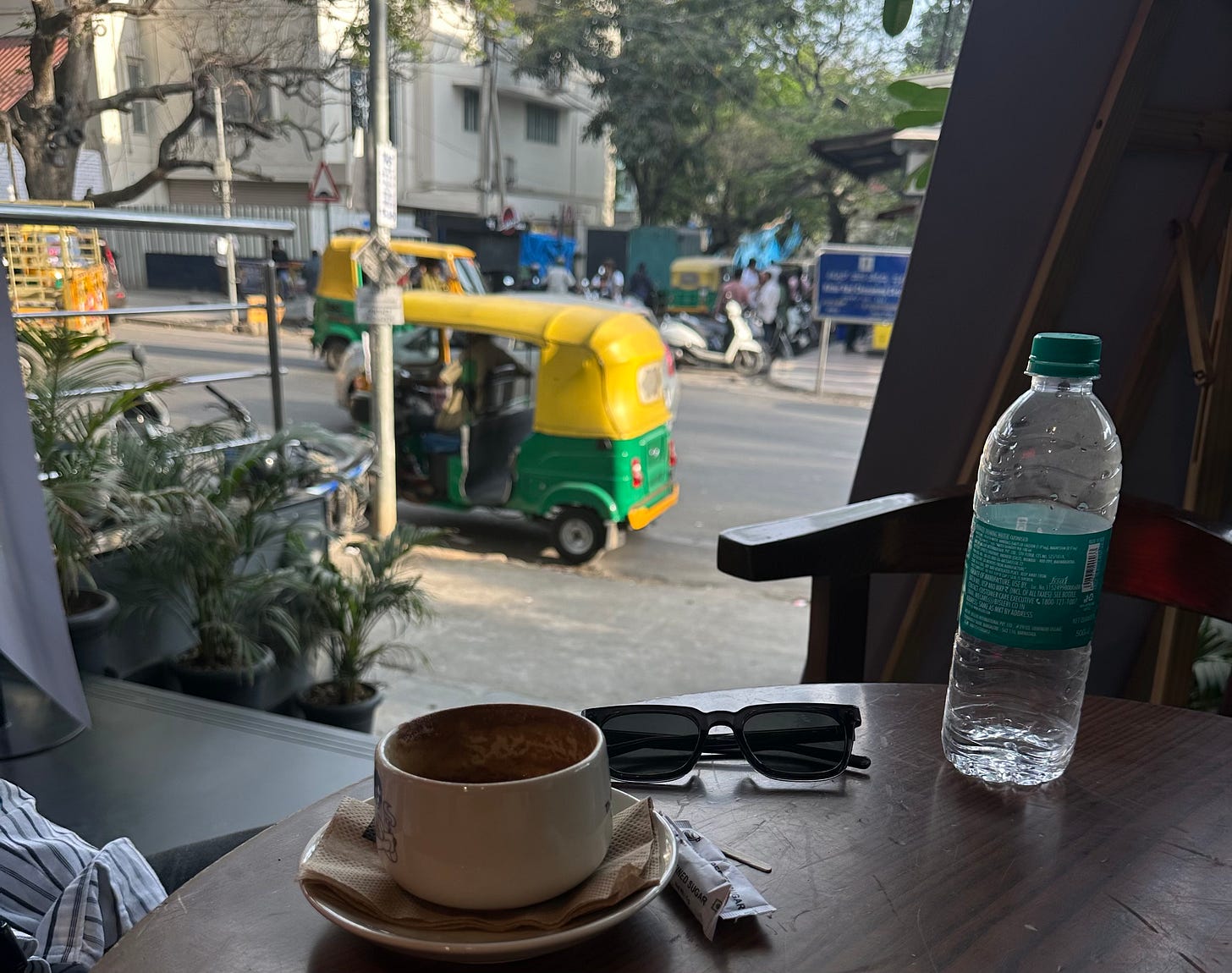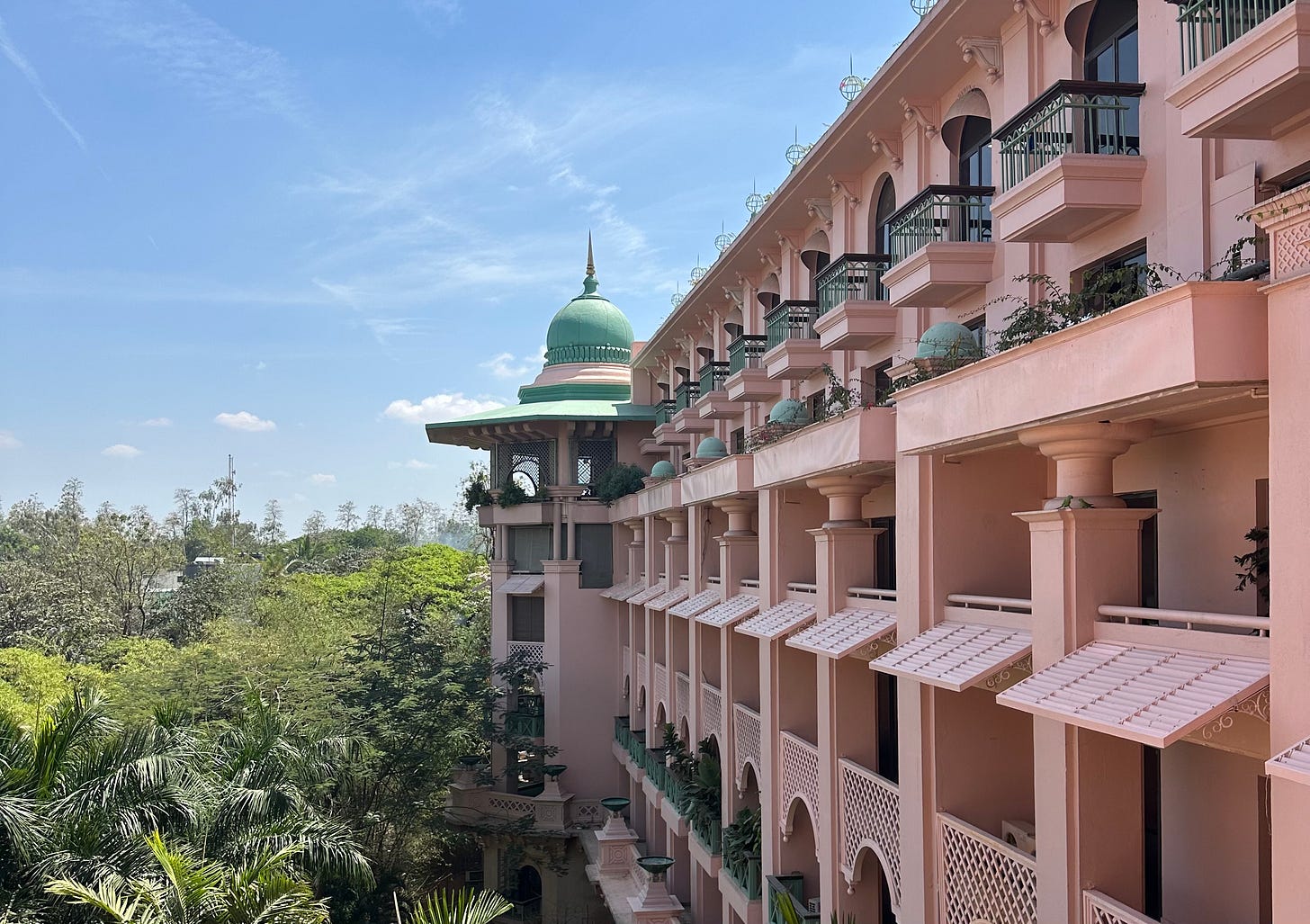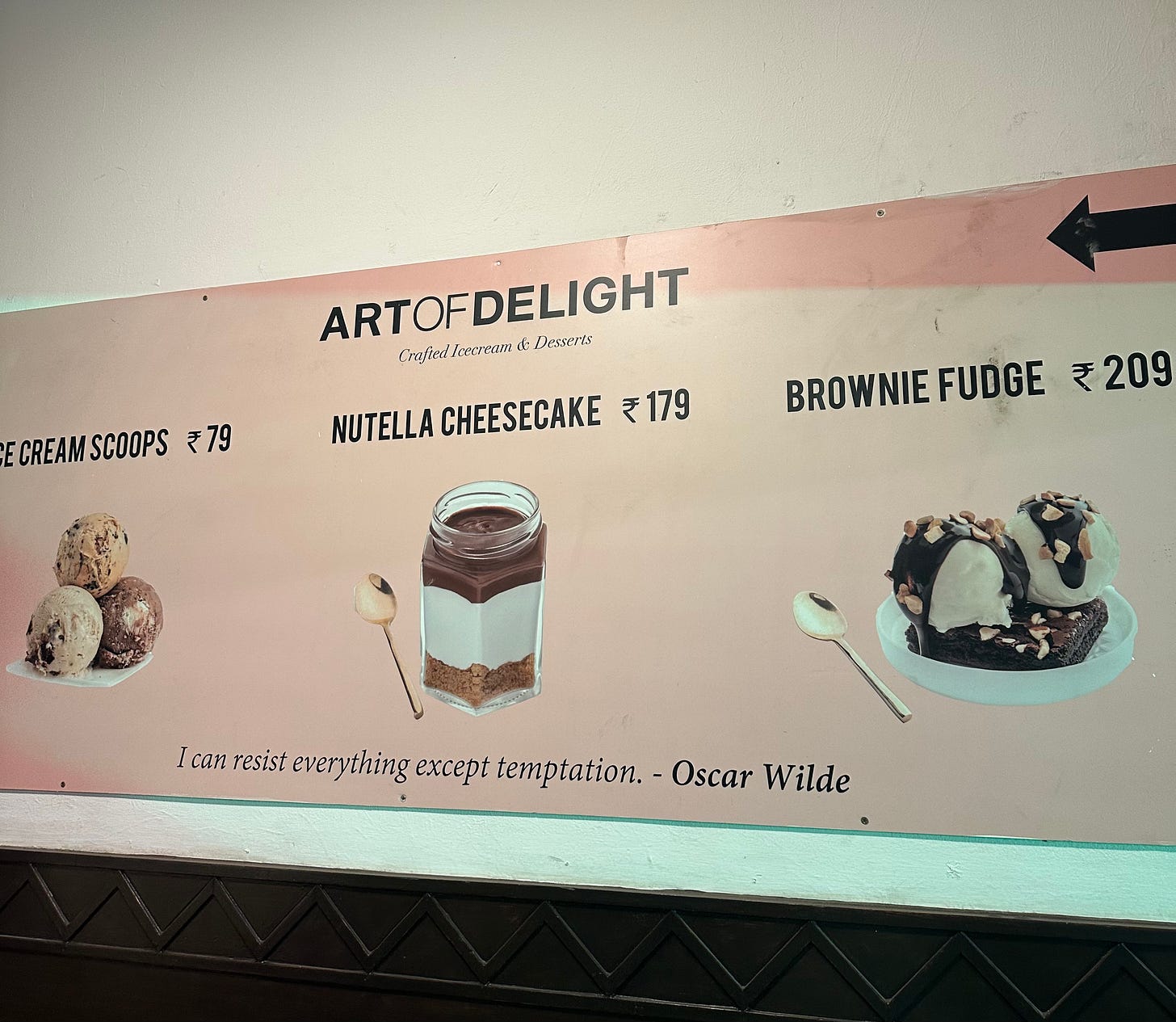I’m sitting at the San Francisco International Airport, sandwiched between two gates: one with a flight headed to Doha, Qatar, and another headed to Paris, France. I people-watch and guess who is going where in my head. Indian families shuffle their children and wheel their elderly relatives around. Balding men sit with round spectacles and skinny jeans. A white man sits at the gate with his socks and shoes off, scrolling on his phone. I assume he’s of the Parisian variety, which may make his public barefootedness a bit more chic. But I hear him speak to the person beside him, and it’s a cornfed American accent. I grow a little nauseous.
I’m headed to Doha, where I’ll catch a connecting flight to Bengaluru, India. As with any international travel, I’m preparing to leave my cultural comforts behind. Bodega snacks, American drugs like Advil, my preferred brand of tampons - these types of things can vary when you travel abroad, which is somehow more jarring than the spoken language or architecture changing. The minute details - the nails in the floorboards, the springs in the watch, as it were - make all the difference.
I see a girl walk into our gate with an Owala water bottle, a claw clip, and one of those green jackets with the circular quilted pattern that everyone started wearing a few years ago. Subconsciously - and then consciously - I’m flooded with comfort by way of familiarity. An American (most likely), marked by her adoption of that neo-niche internet aesthetic. “Instagram store core,” as Charlie Squire once dubbed it.
I’m thinking about how modern culture is the sum of the output of brands. And how American brands don’t always signify “America,” as American brands are ubiquitous with so many cultures. McDonald’s, Coca-Cola, Disney, and so on. Rather, it’s the intentional curation of brand monikers - and the application of these monikers on one’s person - that signify a culture.
A family walks in wearing tight-fitting Gap t-shirts, ill-fitting jeans, and Adidas sneakers - they could be from anywhere. But this girl with the Owala and claw clip and quilted jacket - I feel as though I know her whole story. Kyle Chayka has written about a similar topic at length in his book Filterworld, in which he argues that digital algorithms are flattening and homogenizing modern culture.
To illustrate his point, Chayka uses the example of a minimalist coffee shop - the kind that you can find in just about any major city in the world. New York, London, Seoul, Mexico City, Doha, Paris, and so on. The coffee shop has white subway tile walls, clear acrylic tables, and simple black furniture. The coffee menu is written on the wall in a minimal black font, and the interior may be adorned with leafy green plants. Chayka writes about how this type of establishment is a refuge to the international traveler, plagued with indecision or wary of gambling on too many unknown cafes, unaware of how to discern quality abroad. They see the minimalist coffee shop, and they feel a sense of serenity. Even though it is without context, without identity, and without place. Without culture, really. There is comfort in feeling as though you’re at home, and when you come from a culture of muddled taste, “home” can feel like nowhere in particular.
A couple of days later, my boyfriend and I take an hour-long Uber to a Bengaluru coffee shop, which turns out to be one of these minimalist ones. We don’t mind that the car ride is an hour long because the U.S. dollar is quite strong in India, making the ride cost about five USD. And being a part of the traffic is quite exciting. Road lines are ignored in many parts of the city, making certain intersections a jumbled dance of cars, motorbikes, and rickshaws. It might seem like chaos at first glance, but it’s actually incredibly organized on a second glimpse - each vehicle negotiating and improvising with ease. You think there will be a collision, but then a vehicle will break or swerve at the last minute. If two cars lightly ding each other, no one seems to mind, they’ve got places to be. And cars should be able to touch a little bit, in my opinion.
We arrive at the coffee shop with dust in our lungs. It’s a humid 90 degrees, and the air quality on Apple’s weather app is “Moderate.” Even though we’re sweaty and sweltering, we each order two hot lattes. We’re attending a relative’s wedding in several days and can’t gamble on an iced drink here.
We take our lattes to the cafe patio, which looks onto the street. Young students sip smoothies and study. A group of middle-aged men drink their coffee and smoke cigarettes. After a time, a few more men join them one by one while others peel off, until the group of men is entirely different from the one that was here when we first arrived. Stray dogs with patchy fur wander onto the patio and sniff around before finding a spot of sunlight to nap in.
When the dogs sniff near me, I clam up. I’m pretty terrified of rabies after falling down too many late-night Google rabbit holes on the subject. But these dogs have spent enough time living among humans on the streets, they know to mind their distance. I always feel slightly embarrassed when I exhibit “tourist” behavior like this while abroad. When I don’t have immediate proficiency in a culture. I don’t know who I’m trying to fool as a white girl in India. Assuming behavioral “mastery” in a country I’m visiting for the first time is probably even more embarrassing than an earnest blunder.
I’m thinking about my cultural incompetence the next day when I have two tequila sodas in me and I’m asking my boyfriend - who is Indian - to get mehndi (or “henna”) with me. We’re at the wedding’s welcome drinks, two days before the ceremony. Drinks are being drunk in the hotel foyer, and mehndi is being painted in a ballroom upstairs. My boyfriend’s family has told me that it’s acceptable for men to get mehndi in 2025, so I think my request is no big deal. The bride and groom’s friends - men and women - all wander around the ballroom waving and blowing on their painted hands.
When I ask the artist to tattoo my boyfriend, she smiles a kind smile and looks me in the eyes. “In our culture, we apply mehndi because it’s our tradition. Foreigners come and apply it because it’s ‘art,’“ she says, emphasizing “art” like a dirty word. “You understand the difference?” I’m blushing. I think I understand, so I smile and tell her so.
Tradition takes on a new meaning in India - at least to me. In America, “tradition” is often the dirty word - something that we’re trying to expand or dissolve the boundaries of. Tradition means exclusion. Stagnation. Permanence. But here, as the artist applies the mehndi, there is a sacredness in doing things a certain way because it’s the way they’ve always been done. The flip side of exclusion is selectiveness and certain customs become more sacrosanct when they’re selective. If everyone could do everything anywhere all the time, perhaps the meanings of those things would decay.
I’m thinking about tradition at the wedding ceremony two days later, as I walk in the baraat, or groom’s procession, while the groom rides on horseback to Drake’s “Headlines.” Within twenty minutes of the ceremony beginning, the American guests are getting squirmy. A Western wedding ceremony would probably be over by now. This one spans five hours, in the warm sun with the scent of jasmine wafting from women’s hair.
Much of the ceremony involves participation from the guests, many of whom flew from the other side of the globe to be here. They bring gifts to the bride and groom and play wedding games. Fistfuls of turmeric rice, styrofoam glitter balls, and rose petals shower on the happy couple like fresh snow. If the jet lag is catching up to them, they do their best not to let it show.
A couple of days later, we’re off on a day trip to Kochi, a city in India’s coastal Kerala state. For hundreds of years, the city’s port acted as an important spice trading center, transacting with Romans, Persians, Arabs, Chinese, and so on. The specialty foods in Kochi include the fermented pancake-like bread appam, seafood, and beef stew - we try all of it, and it’s all delicious. Beef is unusual to find in many Indian restaurants, but it makes sense in Kochi, given its complex cultural history.
The draws of conquest, spice, and settlement have long pulled Hindus, Muslims, Christians, and Jews to the region. Of course, people practicing these religions are dispersed throughout the country - throughout the world - but it’s interesting to see such a concentration of varying spiritualities in one spot. On Fort Kochi, Santa Cruz Basilica Cathedral is a ten-minute rickshaw ride from Paradesi Synagogue, which is steps away from Pazhayanur Bhagavathy Temple, which is next door to the Mattancherry Palace, also known as the Dutch Palace, which was built by the Portuguese but captured by the Dutch in 1663. I walk through the palace, marveling at its lacquered wood ceilings with tourists from around the world. Gift shops carry figurines of Ganesha and Jesus side by side.
India, the most populated country in the world at nearly 1.5 billion, is many things - too much for me to see or understand in a two-week trip. What it certainly seems to be, from the outside, is sure of itself. The clothes are vibrant and colorful. The food is sweltering and spicy even when it’s 90 degrees. The people are firm in their resolve. Drivers and motorists weave around each other with assertiveness. The police officers at the airport are armed with assault rifles, but everyone seems to understand that they’re just for show. In Kochi, a man cut me in line at the water taxi ticket booth, and when I told him so, he simply told me he didn’t.
Even amid its many shades of nuance, the parts of India I’ve seen have a uniformity in confidence that is refreshing, at least compared to where I’m coming from - a country that’s having an ongoing public identity crisis. Of course, my perspective is partial - beauty, character, and crisis are relative. Subject to the eye of the beholder. Right now, my perspective is that of a tourist. It’s intoxicating to be foolish in a foreign country. To sample. To feel as though you understand when you’re only just skimming the surface.
On the way home from Kochi, we eat KFC in the airport. For years, my boyfriend has spoken at length about how much better the American fast food chain is in India - spicier, more sumptuous, prepared with more care. It somehow seems more popular too - I saw more KFCs during my two weeks in India than I’ve seen in the last year in the United States. American culture is, once again, like water. Unmarked, invisible, nowhere, everywhere. I take a bite of popcorn chicken and admit that it does taste better here. Certainly.














Seems like a good trip and you just missed the early summer here which is going on nasty these past few days. Tradition! Ha ha. India is a continent I am afraid. It's just too complex for even us to contemplate sitting here. Even with all the traveling and mingling with people from many states, I still feel I have many things to learn and see.
i’m sooo glad u had such an amazing time in my home country! love how you embraced all parts of it, and yes 2 weeks is certainly isn’t enough 😄 i really like how you picked up on subtle cultural differences and came from a point of understanding it and looking through a deeper lens with appreciation, hope you keep the memories for life ❤️